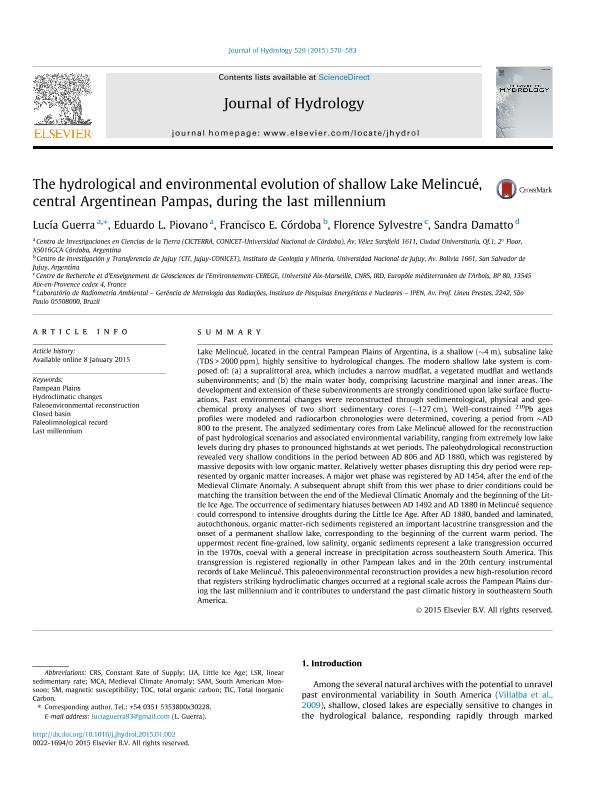Mostrar el registro sencillo del ítem
dc.contributor.author
Guerra, Lucía

dc.contributor.author
Piovano, Eduardo Luis

dc.contributor.author
Cordoba, Francisco Elizalde

dc.contributor.author
Sylvestre, Florence
dc.contributor.author
Damatto, Sandra
dc.date.available
2018-03-05T18:48:23Z
dc.date.issued
2015-10
dc.identifier.citation
Guerra, Lucía; Piovano, Eduardo Luis; Cordoba, Francisco Elizalde; Sylvestre, Florence; Damatto, Sandra; The hydrological and environmental evolution of shallow Lake Melincué, central Argentinean Pampas, during the last millennium; Elsevier Science; Journal Of Hydrology; 529; P2; 10-2015; 570-583
dc.identifier.issn
0022-1694
dc.identifier.uri
http://hdl.handle.net/11336/37821
dc.description.abstract
Lake Melincué, located in the central Pampean Plains of Argentina, is a shallow (~4m), subsaline lake (TDS>2000ppm), highly sensitive to hydrological changes. The modern shallow lake system is composed of: (a) a supralittoral area, which includes a narrow mudflat, a vegetated mudflat and wetlands subenvironments; and (b) the main water body, comprising lacustrine marginal and inner areas. The development and extension of these subenvironments are strongly conditioned upon lake surface fluctuations. Past environmental changes were reconstructed through sedimentological, physical and geochemical proxy analyses of two short sedimentary cores (~127cm). Well-constrained 210Pb ages profiles were modeled and radiocarbon chronologies were determined, covering a period from ~AD 800 to the present. The analyzed sedimentary cores from Lake Melincué allowed for the reconstruction of past hydrological scenarios and associated environmental variability, ranging from extremely low lake levels during dry phases to pronounced highstands at wet periods. The paleohydrological reconstruction revealed very shallow conditions in the period between AD 806 and AD 1880, which was registered by massive deposits with low organic matter. Relatively wetter phases disrupting this dry period were represented by organic matter increases. A major wet phase was registered by AD 1454, after the end of the Medieval Climate Anomaly. A subsequent abrupt shift from this wet phase to drier conditions could be matching the transition between the end of the Medieval Climatic Anomaly and the beginning of the Little Ice Age. The occurrence of sedimentary hiatuses between AD 1492 and AD 1880 in Melincué sequence could correspond to intensive droughts during the Little Ice Age. After AD 1880, banded and laminated, autochthonous, organic matter-rich sediments registered an important lacustrine transgression and the onset of a permanent shallow lake, corresponding to the beginning of the current warm period. The uppermost recent fine-grained, low salinity, organic sediments represent a lake transgression occurred in the 1970s, coeval with a general increase in precipitation across southeastern South America. This transgression is registered regionally in other Pampean lakes and in the 20th century instrumental records of Lake Melincué. This paleoenvironmental reconstruction provides a new high-resolution record that registers striking hydroclimatic changes occurred at a regional scale across the Pampean Plains during the last millennium and it contributes to understand the past climatic history in southeastern South America.
dc.format
application/pdf
dc.language.iso
eng
dc.publisher
Elsevier Science

dc.rights
info:eu-repo/semantics/openAccess
dc.rights.uri
https://creativecommons.org/licenses/by-nc-sa/2.5/ar/
dc.subject
Closed Basin
dc.subject
Hydroclimatic Changes
dc.subject
Last Millennium
dc.subject
Paleoenvironmental Reconstruction
dc.subject
Paleolimnological Record
dc.subject
Pampean Plains
dc.subject.classification
Meteorología y Ciencias Atmosféricas

dc.subject.classification
Ciencias de la Tierra y relacionadas con el Medio Ambiente

dc.subject.classification
CIENCIAS NATURALES Y EXACTAS

dc.title
The hydrological and environmental evolution of shallow Lake Melincué, central Argentinean Pampas, during the last millennium
dc.type
info:eu-repo/semantics/article
dc.type
info:ar-repo/semantics/artículo
dc.type
info:eu-repo/semantics/publishedVersion
dc.date.updated
2018-03-02T14:18:51Z
dc.journal.volume
529
dc.journal.number
P2
dc.journal.pagination
570-583
dc.journal.pais
Países Bajos

dc.journal.ciudad
Amsterdam
dc.description.fil
Fil: Guerra, Lucía. Consejo Nacional de Investigaciones Científicas y Técnicas. Centro Científico Tecnológico Conicet - Córdoba. Centro de Investigaciones en Ciencias de la Tierra. Universidad Nacional de Córdoba. Facultad de Ciencias Exactas Físicas y Naturales. Centro de Investigaciones en Ciencias de la Tierra; Argentina
dc.description.fil
Fil: Piovano, Eduardo Luis. Consejo Nacional de Investigaciones Científicas y Técnicas. Centro Científico Tecnológico Conicet - Córdoba. Centro de Investigaciones en Ciencias de la Tierra. Universidad Nacional de Córdoba. Facultad de Ciencias Exactas Físicas y Naturales. Centro de Investigaciones en Ciencias de la Tierra; Argentina
dc.description.fil
Fil: Cordoba, Francisco Elizalde. Consejo Nacional de Investigaciones Científicas y Técnicas. Centro Científico Tecnológico Conicet - Córdoba. Centro de Investigaciones en Ciencias de la Tierra. Universidad Nacional de Córdoba. Facultad de Ciencias Exactas Físicas y Naturales. Centro de Investigaciones en Ciencias de la Tierra; Argentina
dc.description.fil
Fil: Sylvestre, Florence. Centre National de la Recherche Scientifique; Francia
dc.description.fil
Fil: Damatto, Sandra. Universidade de Sao Paulo; Brasil
dc.journal.title
Journal Of Hydrology

dc.relation.alternativeid
info:eu-repo/semantics/altIdentifier/url/https://www.sciencedirect.com/science/article/pii/S0022169415000074
dc.relation.alternativeid
info:eu-repo/semantics/altIdentifier/doi/http://dx.doi.org/10.1016/j.jhydrol.2015.01.002
Archivos asociados
